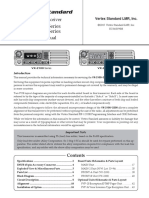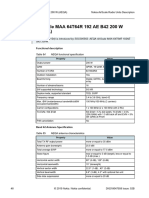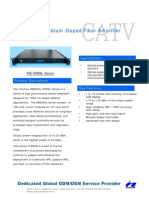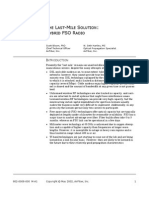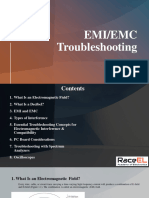AAU5711a (2600Mhz) Technical Specifications
AAU5711a (2600Mhz) Technical Specifications
Uploaded by
Matheus Fortunato AlvesCopyright:
Available Formats
AAU5711a (2600Mhz) Technical Specifications
AAU5711a (2600Mhz) Technical Specifications
Uploaded by
Matheus Fortunato AlvesCopyright
Available Formats
Share this document
Did you find this document useful?
Is this content inappropriate?
Copyright:
Available Formats
AAU5711a (2600Mhz) Technical Specifications
AAU5711a (2600Mhz) Technical Specifications
Uploaded by
Matheus Fortunato AlvesCopyright:
Available Formats
HedEx Startpage Page 1 of 7
3900 & 5900 Series Base Station Product Documentation
Product Version: V100R016C00
Library Version: Draft A
Date: 2019-09-10
For any question, please contact us.
Copyright © Huawei Technologies Co., Ltd. 2019. All rights reserved.
AAU5711a Technical Specifications
Contents
6.2.5.3.4 AAU5711a Technical Specifications
6.2.5.3.4 AAU5711a Technical Specifications
The AAU integrates the antenna and RF unit.
Active Unit Specifications
The specifications of the active unit in the AAU5711a include the supported frequency bands and modes,
capacity, output power, power consumption, and static receiver sensitivity.
Table 1 Frequency bands and modes supported by an AAU5711a
Type Frequency RX Frequency TX Frequency Mode IBW
Band (MHz) Band (MHz) Band (MHz) (MHz)
AAU5711a 1800 1710 to 1785 1805 to 1880 LTE FDD 45
AAU5711a 2600 2500 to 2570 2620 to 2690 LTE FDD 70
NOTE:
• When the AAU5711a is working in the 2600 MHz frequency band and the carrier IBW is
larger than 60 MHz, the frequency of the third-order intermodulation product may fall in
the receive frequency range of a configured carrier under certain spectrum combinations,
http://localhost:7890/printtopics.html?time=Thu Sep 19 13:51:20 UTC-0300 2019 9/19/2019
HedEx Startpage Page 2 of 7
which deteriorates the AAU performance. Ensure that spectrum combinations will not
cause such a problem before configuring carriers.
• There are special laws and regulations in Europe and Australia. Currently, the AAU5711a
(2.6 GHz) cannot be commercially used in the preceding areas.
Table 2 TX/RX channels, capacity, and output power of an AAU5711a
Type Frequency TX/RX Capacity Output Power (W)
Band (MHz) Channel
AAU5711a 1800 32T32R 2 LTE carriers. The 160
bandwidth is 5, 10, 15, For details about
or 20 MHz. typical output power
configurations, see
AAU5711a 2600 32T32R 2 LTE carriers. The Typical Power Configuration
bandwidth is 5, 10, 15, Reference for AAU.
or 20 MHz.
NOTE:
The number of carriers and the maximum bandwidth in actual use depend on the configurations of
optical modules and baseband processing units.
Table 3 EIRP, EIRS, and power consumption of an AAU5711a
Type Frequency EIRP EIRS Typical Power
Band (MHz) Consumption (W)
AAU5711a 1800 Broadcast beam: 52 –106 dBm – 23.2 710
dBm + 16.5 dBi = dBi
68.5 dBm
Traffic beam: 52
dBm + 23.2 dBi =
75.2 dBm
AAU5711a 2600 Broadcast beam: 52 –106 dBm – 24.6 760
dBm + 17.5 dBi = dBi
69.5 dBm
Traffic beam: 52
dBm + 24.6 dBi =
76.6 dBm
NOTE:
• The Typical Power Consumption column provides the power consumption of the
AAU5711a, excluding the power consumption of external RF modules. The typical power
consumption is measured when the ambient temperature is 25°C (77°F) and the AAU is
50% loaded.
http://localhost:7890/printtopics.html?time=Thu Sep 19 13:51:20 UTC-0300 2019 9/19/2019
HedEx Startpage Page 3 of 7
• LTE EIRP and EIRS, as recommended in 3GPP TS 36.104, are measured according to the
FRC A1-3 in Annex A.1 (QPSK, R = 1/3, 25 RBs) standard assuming that the 5 MHz
bandwidth is used.
Antenna Specifications
The AAU5711a uses an 8x8 or 8x12 array structure and consists of 64 or 96 dual-polarized elements.
Table 4 lists its antenna electrical specifications. Figure 1 and Figure 2 show the pattern of broadcast
beams in macro coverage scenarios and pattern of traffic beams, respectively.
Table 4 Antenna electrical specifications of an AAU5711a
Item Specifications Specifications
Frequency Range (MHz) 1800 2600
Broadcast beam Gain 16.5 dBi 17.5 dBi
Horizontal beamwidth 65º±5º 65º±5º
Vertical beamwidth ≥ 8.5° ≥ 5.5°
Vertical tilt range 4° to 10° 5° to 10°
Upper sidelobe 12±2 dB 12±2 dB
suppression
Horizontal edge power 12±2 dB 12±2 dB
decrease between +60°
and –60°
Front-to-rear ratio ≥ 28 dB ≥ 28 dB
Downtilt precision ±1° ±1°
Traffic beam(1) Gain 23.2 dBi 24.6 dBi
Horizontal beamwidth ≤ 15° ≤ 13°
Vertical beamwidth ≤ 10° ≤ 7°
NOTE:
In the table, (1) refers to the traffic beam specifications in typical scenarios where the horizontal and
vertical beam directions are 0° and 8°, respectively.
http://localhost:7890/printtopics.html?time=Thu Sep 19 13:51:20 UTC-0300 2019 9/19/2019
HedEx Startpage Page 4 of 7
Figure 1 Pattern sample of AAU5711a broadcast beams in the macro coverage scenario
Figure 2 Pattern sample of AAU5711a traffic beams
Engineering Specifications
The following table lists the equipment specifications of an AAU5711a.
Table 5 Equipment specifications of an AAU5711a
Type Frequency Power Dimensions (H x W Weight
Band (MHz) x D)
http://localhost:7890/printtopics.html?time=Thu Sep 19 13:51:20 UTC-0300 2019 9/19/2019
HedEx Startpage Page 5 of 7
Type Frequency Power Dimensions (H x W Weight
Band (MHz) x D)
AAU5711a 1800 –48 V DC; voltage 1000 mm x 640 53 kg (116.87 lb)
range: –36 V DC to mm x 175 mm
–57 V DC (39.37 in. x 25.20
in. x 6.89 in.)
AAU5711a 2600 –48 V DC; voltage 1000 mm x 520 52 kg (114.66 lb)
range: –36 V DC to mm x 175 mm
–57 V DC (39.37 in. x 20.47
in. x 6.89 in.)
The following table lists the environmental specifications of an AAU5711a.
Table 6 Environmental specifications of an AAU5711a
Item Specifications
Operating temperature Without solar radiation: –40°C to +55°C (–40°F to +131°F)
With solar radiation: –40°C to +50°C (–40°F to +122°F)
Wind load AAU5711a (1800 MHz)
• Front: 835 N (Assume that the wind speed is 150
km/h.)
• Side: 150 N (Assume that the wind speed is 150 km/h.)
• Rear: 910 N (Assume that the wind speed is 150 km/h.)
AAU5711a (2600 MHz)
• Front: 695 N (Assume that the wind speed is 150
km/h.)
• Side: 170 N (Assume that the wind speed is 150 km/h.)
• Rear: 770 N (Assume that the wind speed is 150 km/h.)
Operating wind speed 150 km/h
Rated wind velocity 200 km/h
Relative humidity 5% RH to 100% RH
Atmospheric pressure 70 kPa to 106 kPa
NOTE:
According to the installation scenario, traffic load, and carrier configuration, the output power of an
AAU decreases when the AAU reaches a temperature 10°C less than its maximum operating
temperature.
The following table lists the compliance standards for an AAU5711a.
http://localhost:7890/printtopics.html?time=Thu Sep 19 13:51:20 UTC-0300 2019 9/19/2019
HedEx Startpage Page 6 of 7
Table 7 Compliance standards for an AAU5711a
Item Standard
RF • 3GPP TS 45.005
• 3GPP TS 25.141
• 3GPP TS 36.141
• 3GPP TS 37.141
Operating environment • 3GPP TS 36.141
• ETSI EN 300019-1-4 V2.1.2 (2003-04) Class 4.1:
"Non-weatherprotected locations"
Storage environment ETSI EN300019-1-1 V2.1.4 (2003-04) Class 1.2:
"Weatherprotected, not temperature-controlled storage locations"
NOTE:
• The validity period is one year.
• The product can function properly within the validity
period if the storage environment meets the preceding
standards.
Shockproof protection • ETS300-2-3 4M5
• YD5083 from the Ministry of Posts and
Telecommunications
Ingress protection IP65
rating
Surge protection • IEC 62305-1 Protection against lightning - Part 1:
General principles
• IEC 62305-3 Protection against lightning - Part 3:
Physical damage to structures and life hazard
• IEC 62305-4 Protection against lightning - Part 4:
Electrical and electronic systems within structures
• ITU-T K.35 Bonding configurations and earthing at
remote electronic sites
• ITU-T K.56 Protection of radio base stations against
lightning discharges
• ITU-T K.97 Lightning protection of distributed base
stations
• ETSI EN 300 253 Environmental Engineering (EE):
Earthing and bonding configuration inside
telecommunications centers
• YD/T 2324-2011: Lightning protection requirements
and test methods for radio base stations
http://localhost:7890/printtopics.html?time=Thu Sep 19 13:51:20 UTC-0300 2019 9/19/2019
HedEx Startpage Page 7 of 7
Item Standard
• GB 50689-2011: Code for design of lightning
protection and earthing engineering for
telecommunication bureaus (stations)
The following table lists the surge protection specifications of ports on an AAU5711a.
NOTE:
• Unless otherwise specified, the surge protection specifications depend on the surge
waveform of 8/20 μs.
• All the surge current items, unless otherwise specified as Maximum discharge current,
refer to Nominal discharge current.
Table 8 Surge protection specifications of ports on an AAU5711a
Port Surge Protection Mode Surge Protection Specifications
Power supply port Surge current Differential mode: 10 kA
Common mode: 20 kA
Specifications of CPRI Ports
The following tables list the specifications of CPRI ports on an AAU5711a.
Table 9 Specifications of CPRI ports on an AAU5711a
Type Number of Protocol CPRI Data Rate CPRI Topology
CPRI Ports Type (Gbit/s)
AAU5711a 2 CPRI 10.1 or 24.3 Star or load sharing
Table 10 AAU5711a CPRI cascading levels and maximum distance from the BBU
Type Cascading Level Maximum Distance from the
BBU (km)
AAU5711a Cascading not supported 20
Parent Topic: Technical Specifications of AAUs
Copyright © Huawei Technologies Co., Ltd.
Copyright © Huawei Technologies Co., Ltd.
< Previous topicNext topic >
http://localhost:7890/printtopics.html?time=Thu Sep 19 13:51:20 UTC-0300 2019 9/19/2019
You might also like
- Nokia AEQQ AntennaDocument6 pagesNokia AEQQ AntennaJoshua BerryNo ratings yet
- AirScale Micro RRH 4T4R B42 - n78 40 W (AWHQE)Document6 pagesAirScale Micro RRH 4T4R B42 - n78 40 W (AWHQE)fabriciotelecom100% (2)
- AQU4518R21V06Document2 pagesAQU4518R21V06luca_allegrettiNo ratings yet
- Problem Set - Sound IntensityDocument1 pageProblem Set - Sound IntensityStef BacalangcoNo ratings yet
- Ocn Grace ShobhaDocument387 pagesOcn Grace ShobhaAsst Prof ECENo ratings yet
- CNSSAM - 01 - 13 - Red Black Installation GuidanceDocument43 pagesCNSSAM - 01 - 13 - Red Black Installation GuidanceTim_CNo ratings yet
- AHDB - Nokia AirScale RRH 2T4R B8 160 WDocument12 pagesAHDB - Nokia AirScale RRH 2T4R B8 160 WNick Lazar100% (1)
- AAU5811 Technical SpecificationsDocument9 pagesAAU5811 Technical SpecificationsJoshua BerryNo ratings yet
- RRU WCDMA 22 XX40 - Data SheetDocument2 pagesRRU WCDMA 22 XX40 - Data SheetMirzet Berilo0% (1)
- Mini Trunk Outdoor Amplifier PCT-MT3646PD: FeaturesDocument14 pagesMini Trunk Outdoor Amplifier PCT-MT3646PD: Featuresjose angel guzman lozanoNo ratings yet
- AIR 2488 DatasheetDocument4 pagesAIR 2488 DatasheetAlerick VelascoNo ratings yet
- ALLIANCE Multi-Operator DAS: Product Specifications / Parts ListDocument4 pagesALLIANCE Multi-Operator DAS: Product Specifications / Parts ListLuisNo ratings yet
- Technical Description: 3G - RRU3808 Description V1.2Document13 pagesTechnical Description: 3G - RRU3808 Description V1.2AMALLYSANo ratings yet
- Litebeam Ac Gen2 ManualDocument8 pagesLitebeam Ac Gen2 Manualmatthew persaudNo ratings yet
- Flexi Remote Radio Head 2TX 900Document5 pagesFlexi Remote Radio Head 2TX 900Reza BordbarNo ratings yet
- AAU3940 Technical SpecificationsDocument9 pagesAAU3940 Technical Specificationsoshwa_ishNo ratings yet
- Flexi Remote Radio Head 2TX 1800Document5 pagesFlexi Remote Radio Head 2TX 1800Reza BordbarNo ratings yet
- WwwweeeeeeDocument7 pagesWwwweeeeeeCristian LlanosNo ratings yet
- Service Manual VX 21002200 Series VHFDocument44 pagesService Manual VX 21002200 Series VHFRubem A S FigueiraNo ratings yet
- ANT-A264518R0v06-1881-001 DatasheetDocument3 pagesANT-A264518R0v06-1881-001 DatasheetjorgeerestrepoNo ratings yet
- MBF-40 Series: Single, Dual, Tri and Quad Band For BrazilDocument3 pagesMBF-40 Series: Single, Dual, Tri and Quad Band For BrazilClaudia MendesNo ratings yet
- ALLIANCE Multi-Operator DAS: Product Specifications / Parts ListDocument5 pagesALLIANCE Multi-Operator DAS: Product Specifications / Parts ListLuisNo ratings yet
- Flexi RF Module 3TX 900 : FXDB Technical Specifications. Functional DescriptionDocument5 pagesFlexi RF Module 3TX 900 : FXDB Technical Specifications. Functional Descriptionnazila100% (1)
- TX Fibra Optica PDFDocument4 pagesTX Fibra Optica PDFMarcoNo ratings yet
- Flexi RFM 6-Pipe 2100 360W (FRGU)Document5 pagesFlexi RFM 6-Pipe 2100 360W (FRGU)Andrei Ghitiu0% (1)
- MX06FHG865 HGDocument3 pagesMX06FHG865 HG208.nampa.idNo ratings yet
- Ant 2 4 CW RCL CCC ds-1890302Document9 pagesAnt 2 4 CW RCL CCC ds-1890302Dinu Racautanu MironNo ratings yet
- Ds Hpa33rte6c v1 - 0 210225Document13 pagesDs Hpa33rte6c v1 - 0 210225Sohaib Hassan KhanNo ratings yet
- Flexi Remote Radio Head 2TX 900 (FHDB) PDFDocument4 pagesFlexi Remote Radio Head 2TX 900 (FHDB) PDFAryaNo ratings yet
- Ic-F30gt Ic-F30gs Ic-F3 1 GT Ic-F3 1 GS: VHF TransceiverDocument38 pagesIc-F30gt Ic-F30gs Ic-F3 1 GT Ic-F3 1 GS: VHF TransceiverJohnNo ratings yet
- Huawei Adu4518r6v06Document2 pagesHuawei Adu4518r6v06РоманКочнев94% (17)
- Litebeam Ac Gen2 ManualDocument13 pagesLitebeam Ac Gen2 ManualsyahruddincivilNo ratings yet
- Antenna BSA-M65-19R010-02 - Ver 1.7 PDFDocument3 pagesAntenna BSA-M65-19R010-02 - Ver 1.7 PDFpandavision76No ratings yet
- Antenna BSA-M65-17R010-42 - Ver 1.2 PDFDocument3 pagesAntenna BSA-M65-17R010-42 - Ver 1.2 PDFpandavision76No ratings yet
- AlphaWireless Product Catalogue 23-2-15 V4Document96 pagesAlphaWireless Product Catalogue 23-2-15 V4piterpzNo ratings yet
- AMB4520R0Document2 pagesAMB4520R0Nicola Leonardo VilardoNo ratings yet
- Wireless Design Seminar 2006Document237 pagesWireless Design Seminar 2006wagnalang1639No ratings yet
- OrBand AL 7107 Especificacao TecnicaDocument6 pagesOrBand AL 7107 Especificacao TecnicaSandip KhopkarNo ratings yet
- Flexi RRH 2-Pipe 2100 120 W (FRGY)Document4 pagesFlexi RRH 2-Pipe 2100 120 W (FRGY)Andrei GhitiuNo ratings yet
- Optimal Profile - Low WindloadDocument2 pagesOptimal Profile - Low WindloadDriss222No ratings yet
- AEQA AirScale MAA 64T64R 192 AE B42 200 W DescriptionDocument5 pagesAEQA AirScale MAA 64T64R 192 AE B42 200 W Description'Theodora GeorgianaNo ratings yet
- Naval 3500 ManualDocument21 pagesNaval 3500 Manualrocky zhengNo ratings yet
- AHGA Radio - DescriptionDocument6 pagesAHGA Radio - DescriptionNick LazarNo ratings yet
- 3bx IIIDocument37 pages3bx IIIAntonio MarraNo ratings yet
- TQP3M9037 Data SheetDocument16 pagesTQP3M9037 Data SheetMarcus HoangNo ratings yet
- Flexi RF Module 3TX 1800Document5 pagesFlexi RF Module 3TX 1800Reza BordbarNo ratings yet
- 790-960 1710-2690 65º 65º 0º-10º 2º-8º Trisector Antenna Half Power Beam Width Adjust. Electr. DowntiltDocument2 pages790-960 1710-2690 65º 65º 0º-10º 2º-8º Trisector Antenna Half Power Beam Width Adjust. Electr. DowntiltJoseNo ratings yet
- 10MHz - 10GHz Noise SourceDocument8 pages10MHz - 10GHz Noise SourceOksana LotitoNo ratings yet
- Functional Description: Introduction To The FeatureDocument27 pagesFunctional Description: Introduction To The FeatureVanek505No ratings yet
- AWEUD MmWave 2T2R n258 55dBm Datasheet v1.2Document2 pagesAWEUD MmWave 2T2R n258 55dBm Datasheet v1.2ZMURF1No ratings yet
- EasymacroDocument65 pagesEasymacroRZNo ratings yet
- Applications: 2440 GHZ Baw FilterDocument6 pagesApplications: 2440 GHZ Baw FilterextractmantorNo ratings yet
- Ne6000l V1Document2 pagesNe6000l V1api-3749499No ratings yet
- Vertex VX-2100Document22 pagesVertex VX-2100Brenton SalassiNo ratings yet
- CCi Hpa65rke6bDocument15 pagesCCi Hpa65rke6bМилена МилошевићNo ratings yet
- HP6 Series Brochure en MobileDocument4 pagesHP6 Series Brochure en Mobiletanajm60No ratings yet
- Flexi RRH 2-Pipe 2100 120 WDocument5 pagesFlexi RRH 2-Pipe 2100 120 WReza BordbarNo ratings yet
- Flexi RF Module 3TX 900 (FXDB) : Functional DescriptionDocument5 pagesFlexi RF Module 3TX 900 (FXDB) : Functional DescriptionnazilaNo ratings yet
- MKT 90Document2 pagesMKT 90javierdb2012No ratings yet
- Reference Guide To Useful Electronic Circuits And Circuit Design Techniques - Part 2From EverandReference Guide To Useful Electronic Circuits And Circuit Design Techniques - Part 2No ratings yet
- Radio Frequency Identification and Sensors: From RFID to Chipless RFIDFrom EverandRadio Frequency Identification and Sensors: From RFID to Chipless RFIDNo ratings yet
- Cmax HM4 30 I53Document2 pagesCmax HM4 30 I53Matheus Fortunato AlvesNo ratings yet
- AAU5636w (3500-3700 MHZ) Hardware Description (01) (PDF) - enDocument20 pagesAAU5636w (3500-3700 MHZ) Hardware Description (01) (PDF) - enMatheus Fortunato AlvesNo ratings yet
- AAU5636w Technical Specifications (V100R018C10 - 05) (PDF) - enDocument37 pagesAAU5636w Technical Specifications (V100R018C10 - 05) (PDF) - enMatheus Fortunato AlvesNo ratings yet
- AAU5368MD Technical Specifications - 2300M + 3500M 1Document12 pagesAAU5368MD Technical Specifications - 2300M + 3500M 1Matheus Fortunato Alves100% (1)
- AAU5636 (3400 MHZ) Hardware Description (Draft A) (PDF) - ENDocument19 pagesAAU5636 (3400 MHZ) Hardware Description (Draft A) (PDF) - ENMatheus Fortunato AlvesNo ratings yet
- T L - M S: H Fso R: HE AST ILE Olution Ybrid AdioDocument20 pagesT L - M S: H Fso R: HE AST ILE Olution Ybrid AdioAzamsalman KhanNo ratings yet
- BETA91A Guide en-USDocument8 pagesBETA91A Guide en-USreinayoon624No ratings yet
- Equipment Noise SpecificationDocument18 pagesEquipment Noise SpecificationNBTC Tubes & PipesNo ratings yet
- Lehle Sunday DriverDocument14 pagesLehle Sunday DriverpikabuNo ratings yet
- UPQ-D1: Wide Coverage LoudspeakerDocument4 pagesUPQ-D1: Wide Coverage Loudspeakerpmacs10No ratings yet
- Nobu FCUs Qty & SelectionDocument7 pagesNobu FCUs Qty & Selectionahmed ragabNo ratings yet
- Mototrbo Digital Two-Way Radio Repeaters: The Future of Business Communication, Delivered TodayDocument8 pagesMototrbo Digital Two-Way Radio Repeaters: The Future of Business Communication, Delivered TodayAhmedElhajNo ratings yet
- SV104 User Manual App CDocument39 pagesSV104 User Manual App CAndresNo ratings yet
- Cell Selection & ReselectionDocument35 pagesCell Selection & ReselectionVugar AliNo ratings yet
- ANT-A114521R1v06-3496-001 DatasheetDocument7 pagesANT-A114521R1v06-3496-001 DatasheetRafael Louie ManaloNo ratings yet
- Microwave Antenna Specifications: 0.6m (2ft) Ultra High Performance Low Profile Antenna SpecificationDocument10 pagesMicrowave Antenna Specifications: 0.6m (2ft) Ultra High Performance Low Profile Antenna Specificationgoran muhamdNo ratings yet
- Tongyu TDJH 182020de 65fDocument1 pageTongyu TDJH 182020de 65fNOKIAXL CJNo ratings yet
- Dxxxx-690-960/1710-2690/1710-2690/1710-2690-65/65/65/65-15I/17.5I/17.5I/17.5I-M/M/M/M-R Easyret 8-Port Antenna With 4 Integrated Rcus - 1.4M Model: Aqu4518R14V07Document3 pagesDxxxx-690-960/1710-2690/1710-2690/1710-2690-65/65/65/65-15I/17.5I/17.5I/17.5I-M/M/M/M-R Easyret 8-Port Antenna With 4 Integrated Rcus - 1.4M Model: Aqu4518R14V07Дмитрий Спиридонов100% (1)
- Ensworth 2017 Full Duplex Bluetooth Low Energy BLDocument4 pagesEnsworth 2017 Full Duplex Bluetooth Low Energy BLAlexis TNo ratings yet
- Noise PredictionDocument7 pagesNoise PredictionEstevan huertasNo ratings yet
- Hull 2013 Criteria - Waterbird Disturbance Mitigation ToolkitDocument36 pagesHull 2013 Criteria - Waterbird Disturbance Mitigation Toolkitjoe.chanNo ratings yet
- Service Manual Nokia 9110Document481 pagesService Manual Nokia 9110Jose Luis100% (1)
- Kampala StudyDocument12 pagesKampala Studyrichardokot09No ratings yet
- RANJU (1) - MergedDocument37 pagesRANJU (1) - MergedNagaraja M LNo ratings yet
- Power Your Signal: Antenna SpecificationsDocument3 pagesPower Your Signal: Antenna SpecificationsвикторNo ratings yet
- Want To Speak About Noisy Neighbours?Document7 pagesWant To Speak About Noisy Neighbours?Wilbur GuerreroNo ratings yet
- EST - Refresher Bring HomeDocument4 pagesEST - Refresher Bring HomeHary Kriz100% (1)
- EMI-EMC TroubleshootingDocument13 pagesEMI-EMC TroubleshootingRobert L.No ratings yet
- Deh 20 UbDocument73 pagesDeh 20 UbDimitar MirchevNo ratings yet
- Bismuth-Doped Fibre Amplifier For The Range 1300 - 1340 NMDocument4 pagesBismuth-Doped Fibre Amplifier For The Range 1300 - 1340 NMkazitoufiqNo ratings yet
- Microwave Path Data Sheet: ComsearchDocument23 pagesMicrowave Path Data Sheet: ComsearchEze Alexander IkNo ratings yet
- Wp541 Coloc Direct RF RecDocument24 pagesWp541 Coloc Direct RF RecRanjit YewaleNo ratings yet


















